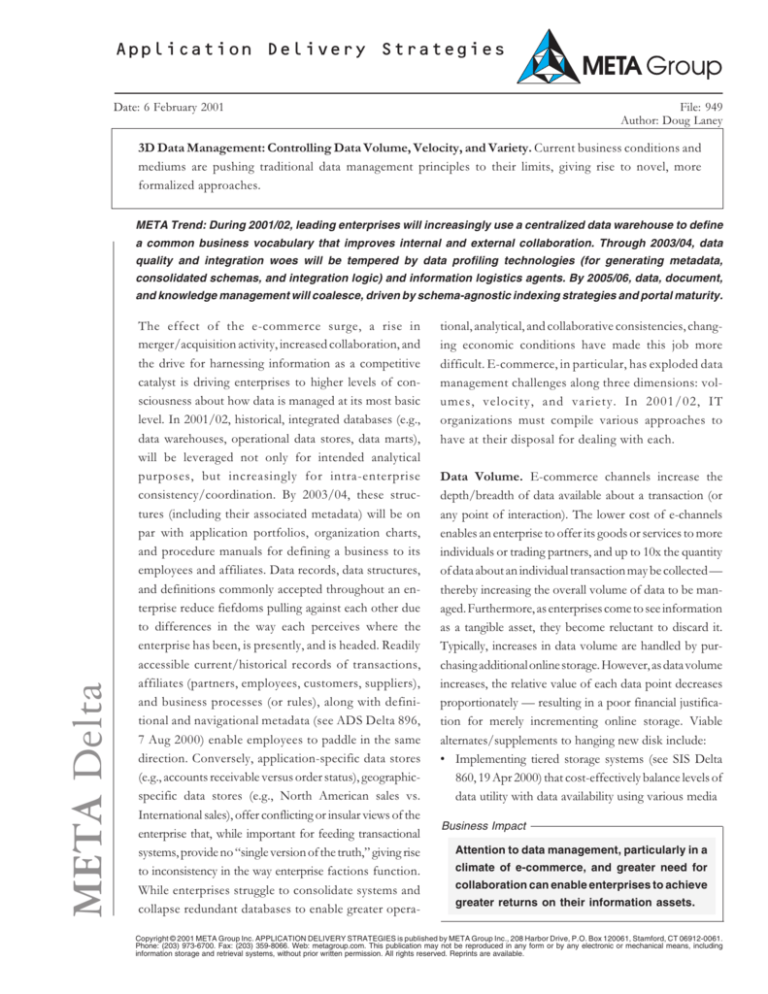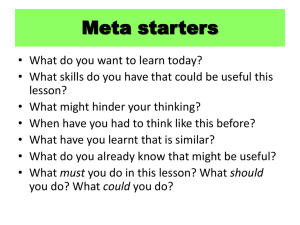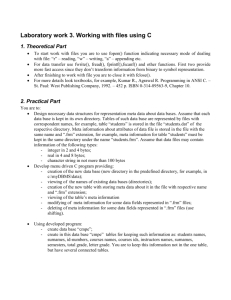
Application Delivery Strategies
Date: 6 February 2001
File: 949
Author: Doug Laney
3D Data Management: Controlling Data Volume, Velocity, and Variety. Current business conditions and
mediums are pushing traditional data management principles to their limits, giving rise to novel, more
formalized approaches.
META Trend: During 2001/02, leading enterprises will increasingly use a centralized data warehouse to define
a common business vocabulary that improves internal and external collaboration. Through 2003/04, data
quality and integration woes will be tempered by data profiling technologies (for generating metadata,
consolidated schemas, and integration logic) and information logistics agents. By 2005/06, data, document,
META Delta
and knowledge management will coalesce, driven by schema-agnostic indexing strategies and portal maturity.
The effect of the e-commerce surge, a rise in
merger/acquisition activity, increased collaboration, and
the drive for harnessing information as a competitive
catalyst is driving enterprises to higher levels of consciousness about how data is managed at its most basic
level. In 2001/02, historical, integrated databases (e.g.,
data warehouses, operational data stores, data marts),
will be leveraged not only for intended analytical
purposes, but increasingly for intra-enterprise
consistency/coordination. By 2003/04, these structures (including their associated metadata) will be on
par with application portfolios, organization charts,
and procedure manuals for defining a business to its
employees and affiliates. Data records, data structures,
and definitions commonly accepted throughout an enterprise reduce fiefdoms pulling against each other due
to differences in the way each perceives where the
enterprise has been, is presently, and is headed. Readily
accessible current/historical records of transactions,
affiliates (partners, employees, customers, suppliers),
and business processes (or rules), along with definitional and navigational metadata (see ADS Delta 896,
7 Aug 2000) enable employees to paddle in the same
direction. Conversely, application-specific data stores
(e.g., accounts receivable versus order status), geographicspecific data stores (e.g., North American sales vs.
International sales), offer conflicting or insular views of the
enterprise that, while important for feeding transactional
systems, provide no single version of the truth, giving rise
to inconsistency in the way enterprise factions function.
While enterprises struggle to consolidate systems and
collapse redundant databases to enable greater opera-
tional, analytical, and collaborative consistencies, changing economic conditions have made this job more
difficult. E-commerce, in particular, has exploded data
management challenges along three dimensions: volumes, velocity, and variety. In 2001/02, IT
organizations must compile various approaches to
have at their disposal for dealing with each.
Data Volume. E-commerce channels increase the
depth/breadth of data available about a transaction (or
any point of interaction). The lower cost of e-channels
enables an enterprise to offer its goods or services to more
individuals or trading partners, and up to 10x the quantity
of data about an individual transaction may be collected
thereby increasing the overall volume of data to be managed. Furthermore, as enterprises come to see information
as a tangible asset, they become reluctant to discard it.
Typically, increases in data volume are handled by purchasing additional online storage. However, as data volume
increases, the relative value of each data point decreases
proportionately resulting in a poor financial justification for merely incrementing online storage. Viable
alternates/supplements to hanging new disk include:
Implementing tiered storage systems (see SIS Delta
860, 19 Apr 2000) that cost-effectively balance levels of
data utility with data availability using various media
Business Impact
Attention to data management, particularly in a
climate of e-commerce, and greater need for
collaboration can enable enterprises to achieve
greater returns on their information assets.
Copyright © 2001 META Group Inc. APPLICATION DELIVERY STRATEGIES is published by META Group Inc., 208 Harbor Drive, P.O. Box 120061, Stamford, CT 06912-0061.
Phone: (203) 973-6700. Fax: (203) 359-8066. Web: metagroup.com. This publication may not be reproduced in any form or by any electronic or mechanical means, including
information storage and retrieval systems, without prior written permission. All rights reserved. Reprints are available.
Data Velocity. E-commerce has also increased
point-of-interaction (POI) speed and, consequently, the
pace data used to support interactions and generated by
interactions. As POI performance is increasingly perceived as a competitive differentiator (e.g., Web site
response, inventory availability analysis, transaction execution, order tracking update, product/service delivery),
so too is an organizations ability to manage data velocity.
Recognizing that data velocity management is much more
than a physical bandwidth and protocol issue, enterprises
are implementing architectural solutions such as:
Operational data stores (ODSs) that periodically
extract, integrate, and reorganize production data for
operational inquiry or tactical analysis
Caches that provide instant access to transaction data
while buffering back-end systems from additional load
and performance degradation (unlike ODSs, caches
are updated according to adaptive business rules and
have schemas that mimic the back-end source)
Point-to-point data routing between databases and
apps (e.g., D2K, DataMirror) that circumvents
high-latency hub/spoke models that are more appropriate for strategic analysis
Designing architectures that balance data latency with app
data requirements and decision cycles, without assuming
the entire information supply chain must be near real time
Data Variety. Through 2003/04, no greater barrier to
effective data management will exist than the variety of
incompatible data formats, non-aligned data structures,
and inconsistent data semantics. By this time, inter-
change/translation mechanisms will be built into most
DBMSs. But until then, app portfolio sprawl (particularly when based on a strategy of autonomous software
implementations due to e-commerce solution immaturity), increased partnerships, and M&A activity intensifies
data variety challenges. Attempts to resolve data variety
issues must be approached as an ongoing endeavor
encompassing the following techniques:
Data profiling (e.g., Data Mentors, Metagenix) to
discover hidden relationships and resolve inconsistencies across multiple data sources (see ADS Delta
898, 23 Aug 2000 )
XML-based data format universal translators that import data into standard XML documents for export into
another data format (e.g., infoShark, XML Solutions)
Enterprise application integration (EAI) predefined adapters (e.g., NEON, Tibco, Mercator) for acquiring and
delivering data between known apps via message queues,
or EAI development kits for building custom adapters
Data access middleware (e.g., Information Builders
EDA/SQL, SAS Access, OLE DB, ODBC) for direct
connectivity between applications and databases
Distributed query management software (e.g., Enth,
InfoRay, Metagon) that adds a data routing and
integration intelligence layer above dumb data
access middleware
Metadata management solutions (i.e., repositories and
schema standards) to capture and make available definitional metadata that can help provide contextual
consistency to enterprise data
Advanced indexing techniques for relating (if not physically
integrating) data of various incompatible types (e.g., multimedia, documents, structured data, business rules)
As with any sufficiently fashionable technology,
users should expect data management marketplace
ebb/flow to yield solutions that consolidate
multiple techniques/solutions that are increasingly
app/environment specific (see Figure 1 in
Addendum). In selecting a technique or technology, enterprises should first perform an information audit assessing
the status of their information supply chain to identify and
prioritize particular data management issues.
Bottom Line
In 2001/02, IT organizations must look beyond traditional direct brute-force physical approaches to data
management. Through 2003/04, practices for resolving e-commerce accelerated data volume, velocity,
and variety issues will become more formalized/diverse. Increasingly, these techniques involve tradeoffs
and architectural solutions that involve/impact application portfolios and business strategy decisions.
Copyright © 2001 META Group Inc.
ADS 6 Feb 01.949
META Delta
Limiting data collected to that which will be leveraged
by current or imminent business processes
Limiting certain analytic structures to a percentage of
statistically valid sample data
Profiling data sources to identify and subsequently
eliminate redundancies
Monitoring data usage to determine cold spots of
unused data that can be eliminated or offloaded to
tape (e.g., Ambeo, BEZ Systems, Teleran)
Outsourcing data management altogether (e.g.,
EDS, IBM)
Application Delivery Strategies
Date: 6 February 2001
File: 949 Addendum
Figure 1 — Data Management Solutions
J Volume
Tiered storage/hub and spoke
Selective data retention
Statistical sampling
Redundancy elimination
Offload “cold” data
Outsourcing
E-Business-Driven Information
Explosion Factors
Channels
Data Collection
Data Retention
&
&
&
&
Operational data stores
Data caches
Point-to-point data routing
Balance data latency with decision cycles
J Variety
&
&
&
&
&
&
Inconsistency resolution
XML-based “universal” translation
Application-aware EAI adapters
Data access middleware and ETLM
Distributed query management
Metadata management
Packaged Solutions
Partnerships
Mergers and Acquisitions
DBMS Specialization
Volume
J Velocity
POI Performance
Info Urgency
Pervasive Computing
Velocity
Va
rie
ty
&
&
&
&
&
&
Extending data management options enables
greater returns on information assets
META Delta
Source: META Group
Copyright © 2001 META Group Inc. APPLICATION DELIVERY STRATEGIES is published by META Group Inc., 208 Harbor Drive, P.O. Box 120061, Stamford, CT 06912-0061.
Phone: (203) 973-6700. Fax: (203) 359-8066. Web: metagroup.com. This publication may not be reproduced in any form or by any electronic or mechanical means, including
information storage and retrieval systems, without prior written permission. All rights reserved. Reprints are available.
META Delta
Copyright © 2001 META Group Inc.
ADS 6 Feb 01.949 Addendum










